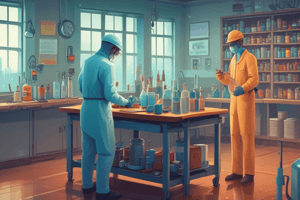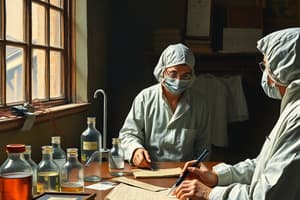Podcast
Questions and Answers
Which of the following scenarios best illustrates the application of a spill response procedure?
Which of the following scenarios best illustrates the application of a spill response procedure?
- A researcher disposes of excess chemicals down the drain to avoid accumulation.
- A lab worker immediately cleans up a chemical spill using a designated spill kit and reports the incident. (correct)
- A student mixes two unknown chemicals to observe the reaction without prior risk assessment.
- A scientist continues an experiment despite noticing a minor chemical odor, assuming it will dissipate.
A research team is designing an experiment. How does systematic thinking, promoted by safety regulations, contribute to the experimental design?
A research team is designing an experiment. How does systematic thinking, promoted by safety regulations, contribute to the experimental design?
- By encouraging a thorough risk assessment and planning of safety measures. (correct)
- By prioritizing cost-cutting measures over safety considerations.
- By limiting creativity and flexibility in the experimental approach.
- By expediting the experimental process to meet deadlines.
A researcher is conducting a study on the effectiveness of a new teaching method. Which type of data would be considered qualitative?
A researcher is conducting a study on the effectiveness of a new teaching method. Which type of data would be considered qualitative?
- Statistical analysis of student grade point averages.
- Student test scores after the implementation of the new method.
- Attendance records of students in the class.
- Transcripts from interviews with students about their learning experiences. (correct)
In an environmental study, researchers collect data on air pollution levels. Which of the following best exemplifies quantitative data collected during the study?
In an environmental study, researchers collect data on air pollution levels. Which of the following best exemplifies quantitative data collected during the study?
A psychology study aims to understand the emotional impact of social media use on teenagers. Which data collection method would yield qualitative data?
A psychology study aims to understand the emotional impact of social media use on teenagers. Which data collection method would yield qualitative data?
A researcher is about to use a chemical from a container, what is the MOST important first step they should take according to laboratory protocols?
A researcher is about to use a chemical from a container, what is the MOST important first step they should take according to laboratory protocols?
Why is balancing samples in a centrifuge essential before starting it?
Why is balancing samples in a centrifuge essential before starting it?
Which of the following scenarios requires the use of a fume hood?
Which of the following scenarios requires the use of a fume hood?
Why is it important to avoid eating or drinking in the laboratory?
Why is it important to avoid eating or drinking in the laboratory?
A researcher notices a small crack in a beaker they are about to use. What should they do?
A researcher notices a small crack in a beaker they are about to use. What should they do?
In microbiological work, what is the purpose of flame sterilizing inoculation loops?
In microbiological work, what is the purpose of flame sterilizing inoculation loops?
When should safety goggles or face shields be worn in the lab?
When should safety goggles or face shields be worn in the lab?
What is the correct procedure for disposing of biological waste?
What is the correct procedure for disposing of biological waste?
A researcher notices an inconsistency in their experimental results. According to proper data reporting protocols, what should they do?
A researcher notices an inconsistency in their experimental results. According to proper data reporting protocols, what should they do?
Why is it important to record observations, methods, and results in real-time in a lab notebook?
Why is it important to record observations, methods, and results in real-time in a lab notebook?
A lab worker accidentally spills a large amount of strong acid on the floor. Following emergency procedures, what is the MOST appropriate first step?
A lab worker accidentally spills a large amount of strong acid on the floor. Following emergency procedures, what is the MOST appropriate first step?
Which of the following actions is NOT a component of proper biological waste disposal?
Which of the following actions is NOT a component of proper biological waste disposal?
In the RAMP principle, what does the 'Assess Risks' step primarily involve?
In the RAMP principle, what does the 'Assess Risks' step primarily involve?
Which fire extinguisher is MOST suitable for extinguishing an electrical fire in a laboratory?
Which fire extinguisher is MOST suitable for extinguishing an electrical fire in a laboratory?
When working with a chemical that poses a respiratory hazard, which of the following control measures is MOST effective for minimizing risk according to the RAMP principle?
When working with a chemical that poses a respiratory hazard, which of the following control measures is MOST effective for minimizing risk according to the RAMP principle?
A researcher assesses the risk of using a highly reactive chemical and determines the likelihood of an explosion is low but the severity would be catastrophic. According to the RAMP principle, what should the researcher prioritize?
A researcher assesses the risk of using a highly reactive chemical and determines the likelihood of an explosion is low but the severity would be catastrophic. According to the RAMP principle, what should the researcher prioritize?
Flashcards
Emergency Procedures in Labs
Emergency Procedures in Labs
Procedures for spills, fires, exposures and ensures personnel know how to respond effectively.
Importance of RAMP
Importance of RAMP
Promotes safety, prevents accidents, ensures compliance and encourages systematic thinking in research.
Qualitative Data
Qualitative Data
Non-numeric data describing qualities or characteristics, often subjective.
Quantitative Data
Quantitative Data
Signup and view all the flashcards
Qualitative Data Analysis
Qualitative Data Analysis
Signup and view all the flashcards
Laboratory Protocols
Laboratory Protocols
Signup and view all the flashcards
Personal Protective Equipment (PPE)
Personal Protective Equipment (PPE)
Signup and view all the flashcards
Chemical Labeling
Chemical Labeling
Signup and view all the flashcards
Handling Volatile Substances
Handling Volatile Substances
Signup and view all the flashcards
Chemical Waste Disposal
Chemical Waste Disposal
Signup and view all the flashcards
Centrifuge Balance
Centrifuge Balance
Signup and view all the flashcards
Sterilization
Sterilization
Signup and view all the flashcards
Aseptic Techniques
Aseptic Techniques
Signup and view all the flashcards
Lab Notebook
Lab Notebook
Signup and view all the flashcards
Data Accuracy
Data Accuracy
Signup and view all the flashcards
Biological Waste
Biological Waste
Signup and view all the flashcards
Glass Waste
Glass Waste
Signup and view all the flashcards
Chemical Spill Response
Chemical Spill Response
Signup and view all the flashcards
RAMP Principle
RAMP Principle
Signup and view all the flashcards
R - Recognize Hazards
R - Recognize Hazards
Signup and view all the flashcards
Study Notes
- Laboratory protocols are essential guidelines that ensure safety, accuracy, and efficiency in scientific experiments and research; they provide instruction on safety measures, proper conduct, equipment use, and data collection methods
General Safety Protocols
- Wear lab coats, gloves, and closed-toe shoes as Personal Protective Equipment (PPE).
- Use safety goggles/face shields when handling chemicals or glassware.
- Wash hands before and after experiments.
- Avoid eating, drinking, or applying cosmetics in the lab.
- Refrain from horseplay or distractions in the lab.
- Instructions should be followed precisely, and clarification requested when unsure.
- Know the location of fire extinguishers, eyewash stations, and first-aid kits.
- Report all spills, breakages, and injuries immediately
Handling Chemicals and Reagents
- Always check and double-check chemical labels before use.
- Avoid using unmarked or unlabeled chemicals.
- Store chemicals according to their hazard classification like flammable, corrosive, or reactive
- Keep acids and bases in separate cabinets.
- Use fume hoods when working with volatile substances.
- Never smell or taste chemicals; waft odors toward your nose when required.
- Dispose of chemicals according to regulations
Equipment Use and Maintenance
- Inspect glassware for cracks before use.
- Handle glassware carefully; clean and dry after experiments.
- Use proper techniques for focusing and adjusting lenses on microscopes.
- Clean microscope lenses with lens paper, not rough materials.
- Balance samples evenly before starting the centrifuge.
- Avoid overloading or opening the centrifuge while it is spinning.
- Never leave Bunsen burners, hot plates, or other heating devices
Biological Safety Protocols
- Sterilize tools and media using autoclaves or heat.
- Flame sterilize inoculation loops in microbiological work.
- Dispose of biological waste in biohazard bins.
- Always handle specimens (bacteria, viruses, tissues) under proper containment levels such as BSL-1 to BSL-4.
- Work near a flame or in a laminar flow hood to maintain sterile conditions, and avoid contamination.
Data Recording and Documentation
- Lab notebooks should include recording observations, methods, and results clearly and in real time.
- Lab notebooks should include dates, experiment names, and step-by-step procedures.
- Repeat experiments for reproducibility and use calibrated instruments for measurements to ensure data accuracy.
- Report results honestly, even if they are unexpected or inconclusive.
- Maintain electronic or hard copies of all data.
Waste Management Protocols
- Chemical waste types (i.e., acids, solvents, organic materials) should be disposed of in labeled containers.
- Use autoclaves or biohazard bags for biological materials.
- Place broken glass in puncture-proof containers, not in regular trash bins.
- Dispose of needles or
Emergency Procedures
- In case of chemical spills, evacuate the area if necessary and use spill kits to neutralize or clean spills.
- Use fire extinguishers with CO2, foam, or powder, depending on the fire type.
- Never use water on electrical or chemical fires.
- Use eyewash stations for chemical exposure to the eyes (flush for 15 minutes), and report injuries immediately and seek medical attention.
RAMP Principle
- A framework that guides the design and execution of experiments, particularly setting goals in safety, efficiency, and reliability in experimental work.
R - Recognize Hazards
- Identify potential hazards associated with the experiment, including properties of materials, equipment, and processes involved.
- Hazards could be chemical, physical, biological, or related to the operational environment.
- Knowing that a chemical is flammable, toxic, or reactive is an example of recognizing a hazard.
A - Assess Risks
- Evaluate the likelihood and severity of harm that could result from each hazard.
- Consider factors such as the concentration of substances, environmental conditions, and possible exposure pathways.
- Assessing the risk of a fire when working with flammable solvents near an open flame is an example of assessing risk.
M - Minimize Risks
- Implement strategies to reduce the identified risks to an acceptable level.
- Apply control measures such as using protective equipment and engineering controls (e.g., fume hoods).
- Substitute with less hazardous materials and apply administrative controls.
- Using gloves, goggles, and a fume hood while handling concentrated acids is an example of minimizing risks.
P - Prepare for Emergencies
- Plan for the unexpected, including having procedures in place for spills, fires, exposures, or other emergencies.
- Ensure that all personnel know how to respond effectively.
- Having a spill kit readily available and knowing how to use it if a chemical spill occurs is an example of preparing for emergencies.
Importance of RAMP
- Promotes a culture of safety in scientific research.
- Helps prevent accidents and injuries.
- Ensures compliance with safety regulations.
- Encourages systematic thinking about experimental design and implementation.
Gathering Data
- Qualitative Data is non-numeric data that describes qualities, characteristics, or categories
- Qualitative Data includes captured subjective information, and often involves observations, descriptions, or interviews.
- Qualitative Data is expressed in words, images, or themes.
- Qualitative Data includes interview transcripts about people's experiences, descriptions of behaviors in a natural setting, and open-ended survey responses.
- Qualitative Data Includes thematic analysis, coding, and narrative interpretation.
- Quantitative Data is numeric data that can be measured and analyzed statistically.
- Quantitative Data is objective and structured, and can be used to identify patterns, trends, or relationships.
- Quantitative Data is often collected through experiments, surveys, or instruments.
- Quantitative Data includes test scores, temperature readings, or income levels, and survey results with Likert scales.
- Quantitative Data requires statistical methods, graphs, and numerical models for Data analysis
Studying That Suits You
Use AI to generate personalized quizzes and flashcards to suit your learning preferences.




